loading 
Fitz Henry Lane
HISTORICAL ARCHIVE • CATALOGUE RAISONNÉ • EDUCATIONAL RESOURCE
An online project under the direction of the CAPE ANN MUSEUM
An online project under the direction of the CAPE ANN MUSEUM
Catalog entry
inv. 38
Gloucester Harbor
1852 Oil on canvas 28 x 48 1/2 in. (71.1 x 123.2 cm) Signed, inscribed, and dated lower right: Fitz H. Lane, Gloucester Mass. 1852.
|
Related Work in the Catalog
Supplementary Images
Provenance (Information known to date; research ongoing.)
the Artist, Gloucester, Mass.
Sidney Mason, 1852
Catalina Juliana Mason Myers
Theodorus B. Myers Mason, Washington, D.C., 1899
Cassie Mason Myers James, Washington, D.C., 1900
City of Gloucester, Gloucester, Mass., 1913
Cape Ann Museum, Gloucester, Mass., 1952
Exhibition History
National Gallery of Art, Washington, District of Columbia, Paintings by Fitz Hugh Lane, May 15–September 5, 1988., no. 7, ills., pp. 26, 18 (detail).
Traveled to: Museum of Fine Arts, Boston, Mass., 5–31, 1988.
Traveled to: Museum of Fine Arts, Boston, Mass., 5–31, 1988.
Cape Ann Historical Association, Gloucester, Massachusetts, Training the Eye and Hand: Fitz Hugh Lane and Nineteenth Century American Drawing Books, September 17, 1993–January 29, 1994.
Published References
The American Neptune, Pictorial Supplement VII: A Selection of Marine Paintings by Fitz Hugh Lane, 1804–1865. Salem, MA: The American Neptune, 1965., pl. XXI, No. 70. ⇒ includes  text
text
Wilmerding, John. Fitz Hugh Lane. New York: Praeger, 1971.
Martha Oaks. "Gloucester At Mid-Century: The World of Fitz Hugh Lane, 1840–1865." Gloucester, Mass.: Cape Ann Historical Society. (exhibition catalogue)., ill., p. 18. ⇒ includes  text
text
Wilmerding, John. Paintings by Fitz Hugh Lane. Washington, DC: National Gallery of Art; in association with Harry N. Abrams, 1988., no. 7, ills. in color, pp. 26, 18, fig. 19, ill. in b/w, p. 81 (detail) pp.
Moses, Michael A. "Mary B. Mellen and Fitz Hugh Lane." Antiques Magazine Vol. CXL, No. 5 (November 1991)., p. 833. ⇒ includes  text
text
Worley, Sharon. "Fitz Hugh Lane and the Legacy of the Codfish Aristocracy." Historical Journal of Massachusetts 32, no. 1 (Winter 2004)., p. 61. ⇒ includes  text
text
Wilmerding, John. Fitz Henry Lane. Gloucester, MA: Cape Ann Historical Association, 2005. Reprint of Fitz Hugh Lane, by John Wilmerding. New York: Praeger, 1971. Includes new information regarding the artist's name., ill. 54, text, pp. 60-61.
Craig, James. Fitz H. Lane: An Artist's Voyage through Nineteenth-Century America. Charleston, SC: The History Press, 2006., fig. 107, pl. 7.
Craig, James. "Fitz Henry Lane: An Affinity for the Sea." Fine Art Connoisseur: The Premier Magazine for Important Collectors 3, Issue 4 (August 2006)., ill., p. 29, pp. 29, 31.
Lovell, Margaretta. "'Fitz Henry Lane, Spectateur de l'Histoire' ('Watching History—Fitz Henry Lane and the Revolutionary Past in Antebellum New England')." In Refaire L'Amerique: Imaginaire et Histoire des Etats-Unis, Didier Aubert & Helene Quanquin. Paris: Presses Sorbonne Nouvelle, 2011, pp. 47–61., fig. 4, p. 54, Gloucester Harbor. ⇒ includes  text
text
Lovell, Margaretta. Painting the Inhabited Landscape: Fitz H. Lane and the Global Reach of Antebellum America. University Park: Pennsylvania State University Press, 2023., fig. 10.
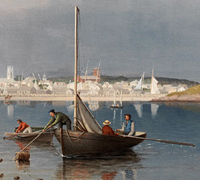
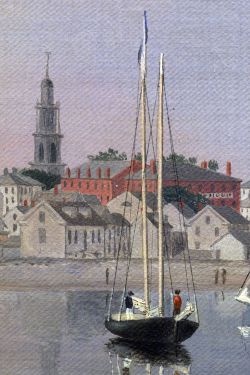
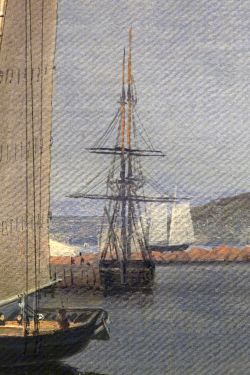
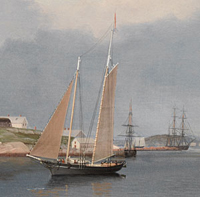
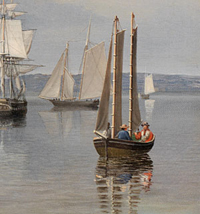
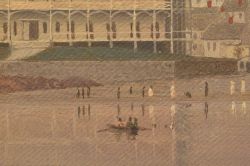
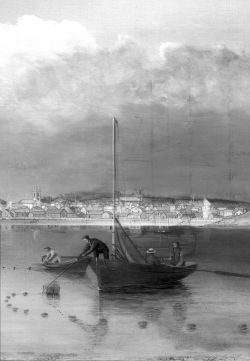
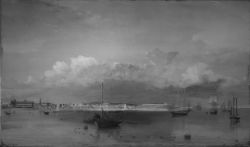
.jpg)
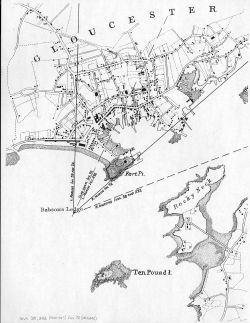
Commentary
The panoramic scale of this work provides the viewer with a sense of the entire city of Gloucester as it was in 1852: its position in the landscape, its harbor, buildings, and boats, and its people and their endeavors. This is one of several Gloucester city scenes that reveal Lane’s lithography training, showing his skill in depicting city and town views. Another example is the earlier painting Gloucester Harbor from Rocky Neck, 1844 (inv. 14).
Lane succeeds brilliantly here; he has managed to pack the scene with an enormous amount of accurately rendered detail, yet Gloucester Harbor feels spacious and open, dominated by a spectacular sky that floats above a still harbor.
The painting was commissioned by Sidney Mason, a prominent Gloucester businessman who was responsible for much of the new waterfront development within the harbor. He also built the Pavilion Hotel—the large, gabled building on the left end of the beach—which was Gloucester’s first tourist hotel. The hotel opened an important new chapter in the city’s economic and cultural life, and one imagines that Sidney Mason was pleased with this painting, both as a visual testament to his civic pride and as a showcase of all he had worked for.
The painting is masterfully composed; Lane has created an effortless order from the complexity of the scene. The eye is led into the harbor by the buoys of the trawl line that arcs to the men in the foreground boat. Behind them, next in the visual trajectory, is the Old Fort, a prominent landmark at the entrance of the Inner Harbor. The Old Fort was a remnant of the 1700s and the Revolutionary War and appears at one end of the beach as a symbol of the old Gloucester. At the other end, Pavilion Hotel represents the new Gloucester. The vessels are also a mix of old and new; small pleasure craft, new to Gloucester, are comingled with the working boats.
The enlargements of the painting below show the extraordinary detail Lane took from his watercolor sketch for this work (Gloucester from the Outer Harbor, 1852 (inv. 72)). The sketch, so scrupulously accurate that one can identify all the buildings and churches—many them still standing today (see Interactive Feature)—was done from a boat at the point in the harbor shown on the map below. It was unusual for Lane to use watercolor as he did in this depiction of the Old Fort.
Note the horseman on the beach and the tourists bathing in front of the hotel. Behind the buildings at the right end of the beach, we can see masts and sails looming up from their anchorages in Harbor Cove, the busiest waterfront area within Gloucester's Inner Harbor at the time. The Fort area was not yet surrounded with wharves and houses, but along the narrow, sandy neck connecting the mainland to the rocky height, one can see the fishing industry warehouses. Lane did not depict the flake yards—where split cod was laid out to dry—as they appear in the 1851 Walling map. The large, white warehouse of George H. Rogers hovers behind the earthworks. The windmill that had once stood on the site of the Pavilion, though here out of sight to the viewer, was tucked behind this warehouse.
Also noticeable are the great variety of vessels that used Gloucester Harbor. Recent conservation infrared images have revealed that originally Lane planned to have a large topsail schooner just to the left of the Fort. Instead he painted over it, and even lowered the sail on the small ship in its place, probably so that the skyline of Gloucester would be more clearly visible.
Lane has imbued this work with a grandeur that belies its fairly ordinary subject matter. There are no heroic activities here, no battles or great pronouncements, yet one is stirred by the promise of the shining white city, the clouds arching overhead, the calm order of the vessels suspended in their reflections. Gloucester here appears as polis, the Greek ideal of the city-state, one that benefits all its citizens. The term was applied to Gloucester by the poet Charles Olson a hundred years after this picture was painted, but it is an apt description of the optimism and idealistic vision of America in the early 1850s.
– Sam Holdsworth